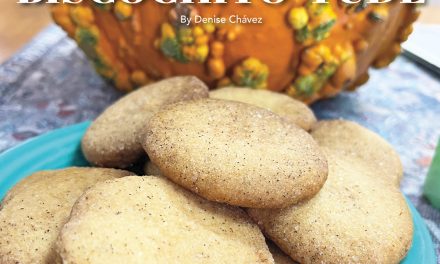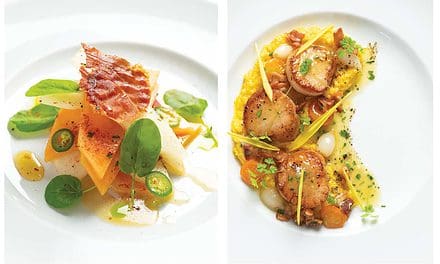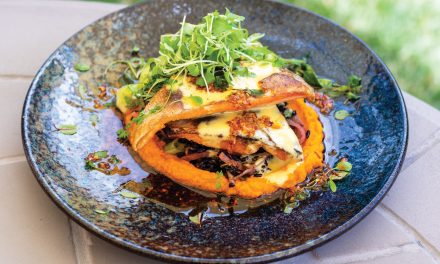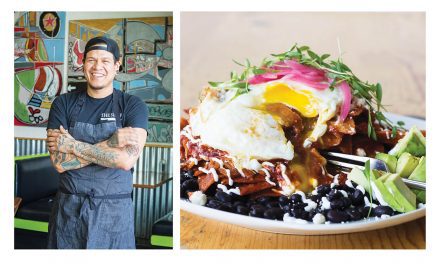
View of the Organ Mountains from East Hadley in the Mesquite Historic District, photo by Stephanie Cameron.
Mesquite Street. La vecindad. Las Cruces, New Mexico. My neighborhood.
My father, Epifanio Chávez Jr., was born in Doña Ana but grew up on Mesquite Street, the very last street on the east side of the city in the 1920s. Beyond was desert, with mesquite trees and their cousins the tornillos, screwbean mesquite trees with spiral seedpods that were used to make flour and medicinal tea. He remembered walking through fields of rabbits to get to school.

Epifanio Chávez Jr.’s childhood home now houses the Mesquite Art Gallery, photo by Stephanie Cameron.
Mesquite Street was the heart of Las Cruces’s original townsite. The historic district dates from the spring of 1849, when Don Pablo Melendres acquired federal approval to establish the new village. Lieutenant Delos Sackett, an army engineer who plotted the streets, erroneously became the official founder for many. Las Cruces, near Mesilla, was once the smaller town. Located directly on the Camino Real, Mesquite Street is one of the most intact neighborhoods of adobe homes from Brownsville, Texas, to Baja California, according to neighborhood historian Sylvia Camuñez.
The river went through here, and yes, the floods were legendary. I remember seeing beams of wood floating down nearby streets after a prodigious rain left the houses rimmed in mud. The east side was where mostly Mexicanos and Mexican Americans lived. In my father’s day, there was one lone Anglo, “El Güero Solo,” who chose this hardworking, colorful, and vibrant neighborhood to make his home.
The Mesquite Street population grew as many Black families moved to the street, some descendants of the Buffalo Soldiers who had founded Blackdom, a utopian settlement in eastern New Mexico. They eventually found their way to southern New Mexico, with many families settling in Vado and on Mesquite Street. Their families, among them the illustrious Petteses, Grimeses, Fielders, and Johnsons, were the true fabric of our community. Clara Belle Williams was the first Black student to graduate from New Mexico College of Agriculture and Mechanic Arts, now New Mexico State University. She was not allowed into the college classrooms and took her notes sitting in the hallway, nor was she able to attend her college graduation. She taught at Booker T. Washington School for more than twenty years, when Las Cruces public schools were segregated, and died in 1994 at age 108. Her birth home at 722 North Mesquite is now registered as a New Mexico Historic Site.
Lula and Alonzo Grimes, the fifth African American family to settle in the neighborhood, moved from Mexico, Missouri, and settled in the house that is now my bookstore, Casa Camino Real. The property was part of the Doña Ana Bend Colony Grant given to Francisco Espalín and his widowed mother, later acquired by the John Bumgardner family. Lula worked as a cook in local school cafeterias, and many told stories of her legendary corn bread and bread pudding. It’s said that everyone had to pass through “Mother Grimes’” bedroom at the back of the house and would be given admittance to the home only after meeting her approval. Some family members were born in what’s now the Bilderbeck Latin American Room, at the front of the house facing Tornillo Street. When my bookstore opened in 2012, the Grimes family asked if they could hold their family reunion there. Never a better red enchilada has been eaten in our building than surrounded by this large, multicultural family. Generations of Grimes family members passed through the rooms, many remembering this legendary matriarch and her saintly ways.
Few had money during those early years, and if they did, they lived on the west side near Pioneer Park and its gazebo. The neighbors were creative and resourceful. Whatever their skills, they found ways to earn a living. In the 1950s, Cecilia Fitch Oliver had the first drive-up restaurant, Cecil’s Snack Bar, which featured homemade taquitos, hamburgers, hot dogs, and raspas/sno-cones in the summer. The Jitney Café on Main Street was the first Black-owned restaurant, run by brothers Daniel and Cortez Hibler. Originally from Texas, the Hiblers also played a role in founding Phillips Chapel, a Colored Methodist Episcopal Church that became the first Black school for Las Cruces when the city implemented segregation in 1924.

Iconic Sunshine Grocery & Grill, photo courtesy of Denise Chávez.
In later years, when my people moved to west Las Cruces, a few relatives stayed on the east side because, after all, it was home. My tiny dynamo of an aunt, Trini Chávez, married to Elias, was legendary for the heat of her red enchiladas. They lived catty-corner to Klein Park. If there was ever a plaza in Las Cruces after the 1967 destruction of St. Genevieve Church, which left a permanent and living ache in our community, it was this park, in use long before it was named for our Jewish mayor, Sam Klein, in 1953. In 2016, the park became home to the Zoot Suit Pachanga and Car Show, a yearly festival celebrating pachuco and lowrider culture with food, fashion, cars, and music. To be Raza, and declare yourself Mexican American or Chicano, in those early days was challenging. Some wanted to get away from Mesquite Street and its history of struggle. One such person was my father, who in his later years always chose to have me drive him around “the old neighborhood.” He may have left to study law at Georgetown University, but the neighborhood never left him. His childhood home, where he always remembered sleeping four to a bed, now houses the Mesquite Art Gallery.
The Mandrake Fine Art and Botanica, a pop-up art space, sits across from the Sunshine Grocery & Grill. Now closed, the iconic and beloved store was owned by the Sánchez family for many years. Later the inimitable and lovely Bestina Sánchez held court outside the store, welcoming everyone inside to buy an orange soda and get free herbs to cure this and that ailment. Her red bougainvillea filled the windows, and there was a shelf of books free for the taking, the first free library in the neighborhood. Nothing was better than to idle the time enjoying a banana ice pop while Bestina regaled you with the local history and the best and most current chisme/gossip.
During the 1970s, my uncle Eduardo Chávez, my father’s brother, also known as Eddie or “Lalo,” opened El Jacal, a Mexican restaurant off Mesquite Street near the Sunshine. Later his son Eddie Jr. ran it. It was housed in a wonderful old adobe and featured my uncle’s artwork on the walls. That restaurant closed in 1978, but one of his murals still graces the lobby of La Posta de Mesilla.




Left: The author’s grandparents, Guadalupe Triviz Chávez and Epifanio Chávez Sr., in front of her father’s childhood home, now the Mesquite Art Gallery. Top right: Guadalupe Triviz Chávez with her daughter Lilian and grandchildren. Bottom right: Epifanio Chávez Sr. Photos courtesy of Denise Chávez.
Mesquite today is a lively hotbed of culture, up-and-coming restaurants, and small businesses, and it shows signs of gentrification, a sign, some might say, of “success.” Others might say it’s about time for it to be “elevated.” I have heard it said that it will become another Mesilla, our nearby tourist town. I hope not. Mesilla is unique and so is Mesquite.
Mesquite Street boasts six galleries, each unique and special with art to please all tastes. Being home and hearth to Chicano and Latino culture as well as a wonderful multicultural mixture of folks who understand what community is about, the neighborhood offers some of the best Mexican food in Las Cruces. It’s best to visit galleries from Thursday through Saturday, as we work on Mesquite Time. Our bookstore is open those days and by appointment as well.
The bookstore has a well-used kitchen painted bright blue, named after my mother, Delfina “Fina” Rede Faver Chávez. Fina’s room has served many people atole, pinole, posole, and mole, as well as champurrado, many cups of Abuelita chocolate, and seemingly never-ending pots of café de olla. We add piloncillo / brown cane sugar, canela/cinnamon, and clavo/clove, sometimes with a bit of orange rind to heighten the flavor of the legendary Mexican coffee. I try to placate fearful coffee drinkers and assure them that they won’t grow hair on their face and that the coffee won’t keep them up all night—and that if it does, that elixir and its richness will be worth it.
One year we offered monthly cenas culturales, themed cultural dinners. Volunteer chefs would select a suggested entrée and all would combine our efforts to present a reasonably priced dinner to the public in a private setting. There was Italian food for a Mario Lanza–inspired event with opera singers from El Paso; a Ukrainian meal with special vodka; and a dinner of paella, tortas españolas, and the most olive oil I have ever cooked with in my life while we read from the work of Federico García Lorca. It was a grand and wild year of cooking great food.



Left: The Hibler brothers, proprietors and chefs, in front of the Jitney Café, circa early 1900s. Middle: The Grimes family reunion hosted by Denise Chávez. Right: Lula Grimes. Photos courtesy of Denise Chávez.
I remember a friend coming into Fina’s room with a surprised and wondrous look as he exclaimed, “Not only are you selling books, but you’re also making candy!” I stood near the stove, harried, discouraged, and completely overwhelmed as my gooey white nougat refused to harden. Inspired by a Christmas Eve tradition in Provence, France, this cena celebrated the Thirteen Desserts of Christmas, representing Jesus and the twelve apostles. My husband, French photographer Daniel Zolinsky, elected to serve calissons d’Aix, the marzipan-like candy made from almond paste and candied melon. The price of candied melon online being very high, he candied his own melon. Everyone was glad when that particular cena was accomplished, delicious as it was!
We are a make-do and get-it-done-with-gusto-and-joy neighborhood. We are a cheerful and alive neighborhood framed by San José Cemetery on one end, facing our beloved Organ Mountains. Not only on Día de los Muertos, but every day, we celebrate our antepasados, our beloved ancestors, who remind us of our temporal time on this planet, and how we should live it with ánimo/spirit/energy. We are a don’t-give-it-up type of neighborhood. We are a “dale el try” neighborhood. We understand challenge, yes, and struggle, and always we persist!
The names of the neighborhood’s founders and early settlers still resonate and attest to their strength of spirit, perseverance, and commitment to community: Clara Belle Williams, Clarence Fielder, Albert Johnson (the first Black mayor in New Mexico), Supreme Court Justice Daniel Sosa, Carlos Sánchez, and so many others who have given the neighborhood and our city valor/value. Their names are remembered like my loving aunt and uncle, Trini and Elias Chávez, who never left la vecindad for greater Las Cruces, because, after all, it was home.
Why write so much about the history of a place? Mesquite Street is my world, my home, and my food culture. I drive through its streets every day. I know its cats, and those dogs that come out in the evening to give the cats a hard time. I know what is new, what is old, what the “haps” are—what is happening. And I know its food.





Top left: Chips and salsas at Nopalito’s. Top middle: Tostadas compuestas with eggs and red chile at La Nueva Casita. Top right: MIA Paper Plane and Pistachio Coupe at Miguel’s. Bottom left: Gorditas plate at Nopalito’s. Bottom right: Coffee at The Bean. Photos by Stephanie Cameron.
To say that I live in a gastronomically rich place is an understatement. Each restaurant in the Mesquite area is unique, distinct, and special in its own way.
Nopalito’s is housed in what was El Templo Bautista, a Baptist church. You can see the alcoves as you walk in. In the front is a large proscenium archway that was the altar; it now leads to the kitchen. Ernestina Gallegos and her husband, José Ramón Gallegos, opened this hometown treasure in 1964 in a small adobe at 226 South Campo Street and later expanded to the church where they first met. Later still, a second location at 2605 Missouri was added when that street was still a dirt road near the outskirts of town. Nopalito’s Galería, created next to the restaurant on Mesquite with the vision of providing the community with all types of regional art, now hosts art events, visiting writers, and workshops, and offers artists and cultural groups a place of visibility and encouragement.
Continuing with its tradition of good family food, Nopalito’s is the heart of the community, an anchor of who we are in this sea of desert that was once part of a greater ocean. Their legendary green chile salsa, warm and savory, is brought to your table when you enter. The enchiladas, red or green, reign, as do the light and savory gorditas. Lately I have become enamored with the tostadas compuestas. And always, there are the sopapillas, the final touch, offered with the care and attention of servers who become family. The head server at Nopalito’s on Mesquite, Paulette Herrera, was my mother’s third-grade student at Conlee Elementary. She remembers that my mother took her under her wing just after Paulette’s own mother died. It was my great honor to give her a gift card presented to me by a giving platform named Crazy Good Turns “to give to a barista or server as a tip and thank them for their hard work this past year.” I knew immediately that no one deserved this honor more than the lovely and gracious Paulette, who always knows what I want to drink and brings it to me as I walk in the door. When I see her, I see my mother standing next to her.
Down the road at La Nueva Casita Cafe, another traditional and family-owned business, the homemade tostadas are wonderful, always crispy, and pair so well with their savory salsita. Breakfast here is blessed: huevos con chorizo offered with refritos or borrachos, the chile relleno omelet served with a side of the best hash browns in town. La Nueva Casita’s menu is among the few featuring fideos and calabacitas; I often order a large bowl of each with flour tortillas. And I would be remiss not to mention the green chile cheese tamales at Roberto’s Mexican Food, founded by community icon Roberto Estrada. I could go on and on. That’s how it is in la vecindad. We love our community and those who feed us. The newest places are The Bean coffee shop, purveyor of specialty coffees and teas, a dynamic and lively and humming place with energy to spare. Next to it is Miguel’s, the most recent addition to the neighborhood. Their menu is eclectic and uses staple foods to springboard into their own distinct style. I look forward to creating my world of favorites. Already I know I love the mojito with coconut juice.


Top left: Denise Chávez, left, with Paulette Herrera, head server at Nopalito’s on Mesquite. Photo courtesy of Denise Chávez. Bottom left: Mesquite Street Mural at The Bean. Top right: Exterior of Casa Camino Real bookstore. Bottom right: Interior of Casa Camino Real. Photos by Stephanie Cameron.


Of course, there is also El Indio Tortilla Shop at the north end of Mesquite Street, owned by the Castillo family and home of some of the best corn and flour tortillas in town. That is the place to buy nixtamal—cooked masa de maíz—for your tamales. This family business embraces community and no one who enters is a stranger.
The history of Mesquite Street is memorable. People were entrepreneurs of the best kind, full of grit and a strong work ethic. If you knew how to sew, that was your business; if you were a good cook, that became your trade. The neighborhood was sacred, many refusing to leave. Why? What for? Many had left for California only to return, as did most of my Chávez family.
The neighborhood had an energy that was vital and real. Possibility reigned. You might find gold in “them thar hills” or become a farmer. You could become an artist or a doctor or a lawyer. The choice was yours. The ability to project, literally, and to transform, to extend yourself creatively was the norm and, yes, a mandate. The neighborhood was a mixture of both living space and workspace, and that is still its strength.
Our neighborhood is loved. To know its history, its struggles, its culture, its people, and its food is to celebrate our oneness with humanity. And in this knowledge comes the greater knowing of where one fits into the scheme of things. I’m a hometown girl. Always will be.
This is my challenge. My comfort. And my blessing.
Recipes
CORN BREAD BY LULA GRIMES
Reprinted with the permisson of the Grimes family
- 2 cups cornmeal
- 1 cup flour
- 2 tablespoons baking powder
- 1/2 teaspoon salt
- 1–2 cups buttermilk, as needed
- 1 cup melted shortening
- 2 eggs, beaten well
Preheat oven to 350°F. Combine eggs and shortening. Add cornmeal, flour, baking powder, and salt. Add enough buttermilk to dry ingredients to make a light, creamy dough. Pour into a well-greased pan, about 9×8 inches, and bake until a toothpick inserted in the middle comes out clean.
FIDEOS CHÁVEZ
The ultimate comfort food anytime of the year. It’s rare to find this delicious soup in restaurants, so if you do, order it immediately.
- 1 package coiled vermicelli (I always try to get the coiled variety, as it’s fun to crunch into the pan. I grew up with this variety and it has a textural element I love.)
- 1 can tomato paste, tomato sauce, or diced tomatoes—your choice (You should have some paste or sauce for the juice and, if you choose, a chunky element with diced tomatoes, fresh or canned. Some people prefer a dry fideo, some a soupy one. Both are delicious.)
- 1 medium onion, finely chopped
- 3–4 tablespoons oil (I use a mixture of olive and canola)
- Salt, to taste
- Cumin, to taste
Sauté onion in oil. When onion is soft and translucent, add vermicelli one crunched coil at a time. Blend onion and vermicelli. Sauté mixture until browned.
Add a can of tomato sauce (or other tomato element) and mix. Add hot water (about two cans) to cover the top of the vermicelli. Add a good pinch of comino/cumin.
Turn down the heat and let the mixture simmer until the water is absorbed and the fideo is nearly cooked, about ten minutes on low. Then cover, turn off the heat, and let it rest. It will finish its cooking quietly and peacefully in silence. This resting time is recommended as it allows the fideo to find its integrity.
Fideo accepts all. You can add pre-fried ground beef or cook it with the onion. You can also add peas or any vegetable. Green chile is delicious in a fideo. I like my fideo plain and simple.
The fideo is tasty day or night, and the next day’s leftovers are still wonderful. ¡Buen provecho!
More to Explore
GALLERIES
- The First Friday Art Ramble is a monthly arts and gallery hop on Main and Mesquite Streets
- Nopalito’s Galeria, 326 S Mesquite St
- Mesquite Art Gallery, 340 N Mesquite St
- The Mandrake Fine Art & Botanica, 501 E Hadley Ave
- Unsettled Gallery and Studio, 905 N Mesquite St
- Duende Gallery, 921 N Mesquite St
- Gallery 925, 925 N Mesquite St
- Trails End Gallery, 1732 N Mesquite St
NEARBY PLACES OF NOTE
- Phillips Chapel CME Church, 638 N Tornillo St, served as a school for African American students during segregation until 1954. It is still a church.
- Jardín de Mesquite, on the north side of the Mesquite Historic District, features colorful murals representing the history of the neighborhood. Created by Glenn Schwaiger, the ceramic murals are displayed within the park for all to enjoy.
- Our Lady of Health Catholic Church, 1178 N Mesquite St, was one of the first churches to give mass in Spanish. This architectural delight, reminiscent of churches in México, celebrates its anniversary this year.
RECOMMENDED BOOKS ON LAS CRUCES
- Our Heritage, Our People: Selections from the Mesilla Valley by Ella Banegas Curry and Shan Nichols
- Two Ranges by Mesquite native and retired engineer Robert C. Medina. This book, which highlights the early days of the White Sands Missile Range, was the first to be published by a Chicano writer from Las Cruces.
- Las Cruces: An Illustrated History by Linda G. Harris
- Blackdom, New Mexico: The Significance of the Afro-Frontier, 1900–1930 by Timothy E. Nelson
- Cecilia-isms: Dichos de Mi Madre (forthcoming) by Irene Oliver-Lewis
Thank you to Mesquite Street vecinos for their input, knowledge, and support: Sylvia Camuñez and Las Esperanzas, Irene Oliver-Lewis, the Gallegos family from Nopalito’s, and Faith Hutson and the Mesquite Street Amigos, who are organizing events throughout the year to celebrate Las Cruces’s 175th birthday. Many Mesquite-lleros continue to protect and uplift the neighborhood.

Denise Chávez
Denise Chávezis a writer and owner of Casa Camino Real bookstore in Las Cruces. She is the author of The King and Queen of Comezón; A Taco Testimony: Meditations on Family, Food and Culture; Loving Pedro Infante; Face of an Angel; and The Last of the Menu Girls, among other works. Chávez is the winner of the American Book Award and the New Mexico Governor’s Award in Literature. Her long-term project, Museo de La Gente / Museum of the People, is the formation of a community resource center, library, bookstore, and living archive of the Borderland region based in her hometown. After all the hullabaloo, she has decided to write a book called Biscochos/Biscochitos: The Cookie.














